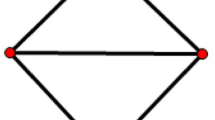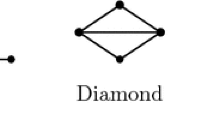Abstract
Let G be the diamond (the graph obtained from K 4 by deleting an edge) and, for every n ≥ 4, let f(n, G) be the minimum integer k such that, for every edge-coloring of the complete graph of order n which uses exactly k colors, there is at least one copy of G all whose edges have different colors. Let ext(n, {C 3, C 4}) be the maximum number of edges of a graph on n vertices free of triangles and squares. Here we prove that for every n ≥ 4,
Similar content being viewed by others
References
Axenovich M., Jiang T.: Anti-Ramsey numbers for small complete bipartite graphs. Ars Combin. 73, 311–318 (2004)
Erdös, P., Simonovits, M., Sós, V.T.: Anti-Ramsey theorems. Colloquia Mathematica Societatis János Bolyai 10 Infinite and finite sets, Keszthely, Hungary, pp. 633–643 (1973)
Jiang T.: Edge-colorings with no large polychromatic stars. Graphs Combin. 18(2), 303–308 (2002)
Montellano-Ballesteros J.J., Neumann-Lara V.: An anti-Ramsey theorem on cycles. Graphs Combin 21(3), 343–354 (2005)
Simonovits M., Sós V.T.: On Restricted Colorings of K n . Combinatorica 4(1), 101–110 (1984)
Author information
Authors and Affiliations
Corresponding author
Rights and permissions
About this article
Cite this article
Montellano-Ballesteros, J.J. An Anti-Ramsey Theorem on Diamonds. Graphs and Combinatorics 26, 283–291 (2010). https://doi.org/10.1007/s00373-010-0902-4
Received:
Revised:
Published:
Issue Date:
DOI: https://doi.org/10.1007/s00373-010-0902-4




